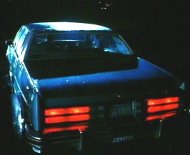Article from: www.thenewspaper.com/news/40/4012.asp
1/30/2013
Courts Deal With Broken Taillight Stops
Wisconsin appellate court rejects bogus taillight stop while Arizona judicial panel re-instates such stops.
 Appellate judges in Wisconsin and Arizona disputed this month over whether motorists should be pulled over if their tail lights appear to be burned out. Wisconsin's Court of Appeals on January 15 overturned a circuit court judge who saw no problem with Milwaukee Police Officer Michael Wawrzonek's decision on July 3, 2010 to stop Antonio D. Brown's 1977 Buick Electra over its tail lights.
Appellate judges in Wisconsin and Arizona disputed this month over whether motorists should be pulled over if their tail lights appear to be burned out. Wisconsin's Court of Appeals on January 15 overturned a circuit court judge who saw no problem with Milwaukee Police Officer Michael Wawrzonek's decision on July 3, 2010 to stop Antonio D. Brown's 1977 Buick Electra over its tail lights.
"It was the driver side tail lamp," Officer Wawrzonek said at trial. "There is a wide band and there is actually three light panels on that wide band and one of those panels was out."
This is consistent with the design of the lamp as the middle bulb, used for a brake light, is not illuminated unless the car is stopping. The circuit court judge ruled that even if the officer was wrong, he still had a valid basis to initiate a stop. Brown appealed, arguing state law does not require every bulb to be functional, and the three-judge panel agreed.
"The statute does not require that a vehicle's tail lamps be fully functional or in perfect working order," Judge Kitty K. Brennan wrote. "It only requires 'good working order.' Because the two lit light bulbs on the rear driverís side of the vehicle were sufficient to designate the rear of the vehicle to a vehicle travelling behind it, the officers did not have probable cause of a traffic violation and the stop was unconstitutional. The officers mistakenly believed that the law required all of the tail lamps light bulbs to be lit; and a lawful stop cannot be predicated upon a mistake of law."
The judges reversed Brown's conviction (![]() view Wisconsin ruling, 65k PDF).
view Wisconsin ruling, 65k PDF).
In Arizona, the Court of Appeals on January 10 decided to overturn a precedent that did not allow police officers to stop and interrogate drivers simply because one of three taillights was burned out. Graham County Sheriff's Deputy Jacob Carpenter pulled over Guillermo Becerra because his right taillight was not working. Under Arizona Code 28-925, a vehicle only needs "at least one tail lamp" to drive. A 2011 appellate court case, Arizona v. Fikes, backed up this interpretation by finding a Fourth Amendment violation to stop someone based solely on a non-functional taillight. Here, a new three-judge panel decided to impose a new interpretation.
"In Fikes, the officer did not testify that he was motivated by public safety or community welfare," Judge Virginia C. Kelly ruled. "And nothing in the record indicated any other driver was or could have been confused."
The Fikes ruling was made by the appellate court Division Two, Department A. A three-judge panel of Division Two, Department B did not like their colleagues' conclusion and found an alternative explanation to justify a traffic stop.
"In this case, however, Carpenter testified that one reason he decided to stop the vehicle was that 'it caused a danger to other vehicles on the road,'" Judge Kelly wrote. "He was concerned another vehicle approaching from the rear would not be able to perceive accurately the vehicle's position and could 'collide with it. In its ruling on the motion, the trial court found Carpenter's stop of the vehicle justified because it 'was being operated in an unsafe condition.'"
The appellate judges insisted there was no Fourth Amendment violation because the police officer's stop and search was justified by public safety concerns, even though Becerra's vehicle was in compliance with the law.
"[Becerra] has not supported his suggestion that law enforcement's public safety function is limited to identifying statutory violations, and relevant case law suggests otherwise," Judge Kelly wrote.
The court upheld Becerra's conviction (![]() view Arizona ruling, 150k PDF).
view Arizona ruling, 150k PDF).
 Appellate judges in Wisconsin and Arizona disputed this month over whether motorists should be pulled over if their tail lights appear to be burned out. Wisconsin's Court of Appeals on January 15 overturned a circuit court judge who saw no problem with Milwaukee Police Officer Michael Wawrzonek's decision on July 3, 2010 to stop Antonio D. Brown's 1977 Buick Electra over its tail lights.
Appellate judges in Wisconsin and Arizona disputed this month over whether motorists should be pulled over if their tail lights appear to be burned out. Wisconsin's Court of Appeals on January 15 overturned a circuit court judge who saw no problem with Milwaukee Police Officer Michael Wawrzonek's decision on July 3, 2010 to stop Antonio D. Brown's 1977 Buick Electra over its tail lights.